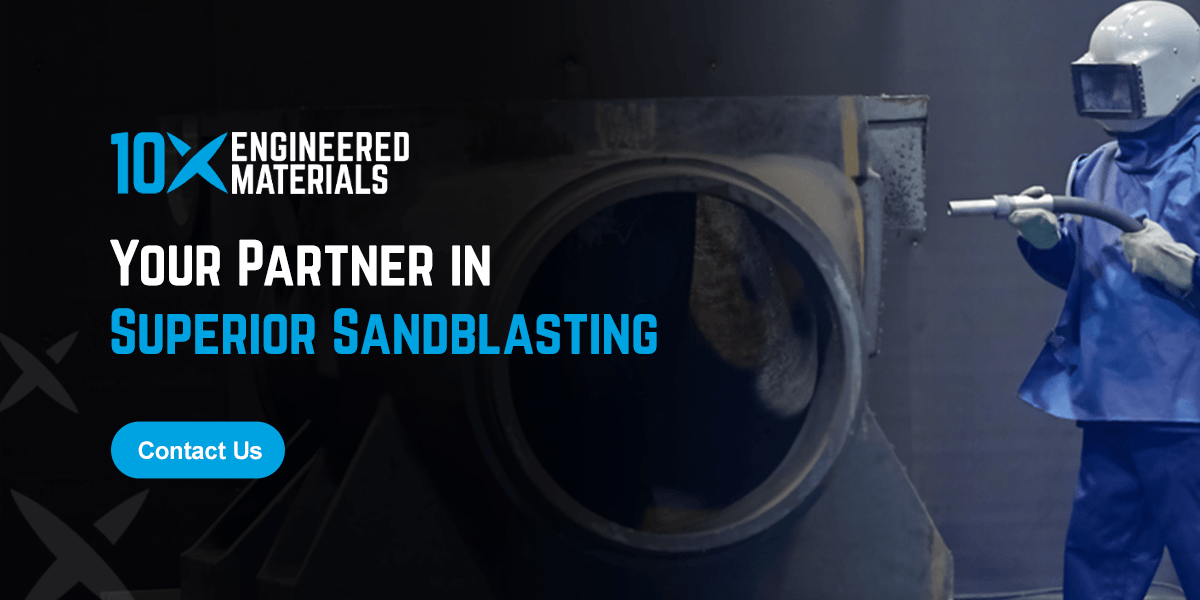5 Different Types of Sandblasters and Their Uses
Sandblasting, also referred to as abrasive blasting, is a surface cleaning and preparation process that uses pressurized air to propel abrasive particles at high speeds. These particles effectively cut through rust, corrosion, paint, and other tough coatings on metal and various surfaces.
In addition to metal, sandblasting is commonly used to prepare concrete surfaces for coating, however it requires specific techniques and abrasive media to achieve the desired surface profile.
While abrasive blasting is an effective surface preparation method for many applications, achieving the desired results requires using the right type of sandblaster and the correct media. In this guide, we’ll explore four types of sandblasters and their common use cases to help you make an informed choice.
1. Wheel Abrator
A wheel abrator is a blasting machine that uses abrasive materials — usually metallic abrasives like steel grit or steel shot — to clean or finish surfaces. The sandblaster works by rotating a blast wheel or set of wheels or paddles to propel the media at the surface of the workpiece. The operator manipulates the objects to ensure they are blasted evenly.
Wheel abrator blasting machines come in various types, including tumbleblast, spinners, and table machines. They are usually used in industrial settings for large-scale applications involving rust and scale removal, die-casting cleaning, or shot peening. These sandblasters are suitable for various materials and deliver an accurate blasting pattern even when working with small, targeted areas.
2. Gravity-Fed Sandblaster
Another type of sandblaster to consider is the gravity-fed sandblaster. As the name implies, gravity plays a crucial role in the operation of this machine. Abrasives are loaded into the hopper, which is located at the top of the sandblaster, and pulled down by gravity when the operator activates the blasting nozzle.
Gravity-fed sandblasters are simple to operate and easy to use, but they have limited effectiveness. The operator has to keep the machine upright and pull the nozzle switch to dispense the media. The sandblasting process can be ended by releasing the switch, which closes the opening between the barrel and the hopper. This type of sandblaster is ideal for smaller blasting jobs and hobbyist-level blasting. However, gravity-fed sandblasters are generally unsuitable for most businesses with high volumes of parts or large surface areas to blast, as the effectiveness of this equipment is limited.
3. Pressure Pot Sandblaster
Pressure pot sandblasters come equipped with a pressure vessel, commonly referred to as the blasting pot, that holds the abrasive media. The machine also has a blasting nozzle and a deadman switch attached to the controls of the blasting pot. When it is turned on, the pressurized air forces the abrasives out through the blast hose, resulting in quick, effective sandblasting.
Since these types of sandblasters use direct pressure, they generate considerable force and are ideal for stripping away stubborn finishes such as powder coating, pack rust, or tough liquid paints, to name a few. Pressure pot sandblasters with a pressure hold system are generally what most blasters will end up using if blasting is a major part of their business. These types of sandblasters are ideal for production-level blasting operations that rely on blasting as a major part of their business.
4. Siphon Sandblaster
Similar to pressure sandblasters, siphon sandblasters draw blasting media out of a container. However, these types of sandblasters operate using suction instead of pressure. A suction system pulls the abrasive media through a hose and delivers it to a blasting nozzle for sandblasting. The media can also be sifted back into the container for reuse.
Siphon sandblasters are easy to operate and tend to be less expensive on the upfront costs but have a higher ongoing cost. These types of sandblasters are best suited for cleaning lighter surface materials where a gentle touch is needed to prevent damage.
5. Vapor Sandblaster
These types of sandblasters operate by injecting a mixture of water, abrasive media, and compressed air into the blast hose to clean and finish surfaces. The water helps to suppress dust, and in specific applications that are sensitive to temperatures from the friction of abrasive blasting, they can be beneficial in keeping the surface temperatures lower during blasting.
Because they can be operated with a lower dust generation footprint, in some cases, workers can minimize the need for containment of the vapor blasting work area. These types of sandblasters can also be used for cleaning and de-greasing.
Your Partner in Superior Sandblasting
Choosing the right kind of sandblasting machine for your project is essential. By matching the sandblaster to the job, you ensure better results, save time, and prevent unnecessary damage to the workpiece. Once you have chosen a sandblaster, the next decision you need to make is selecting the best abrasive media for your application.
10X Engineered Materials provides a range of high-performance abrasives engineered to enhance efficiency, productivity, and safety. Our superoxalloy abrasives are among the most technologically advanced solutions on the market, from the materials used in creating them to the production process itself.
Make an engineered decision and partner with us for practical, sustainable, cost-effective blasting solutions. Browse our selection of abrasive media and contact our team to learn more today.

